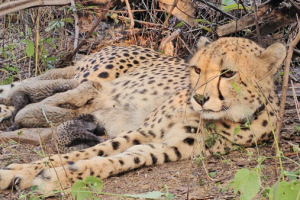
BY DR. RAVINDER PALL SAINI
INDIAN FOREST SERVICE ( RETIRED)
MEMBER, BOARD OF MANAGEMENT
FOREST RESEARCH UNIVERSITY
DEHRADUN
DEHRADUN 1 APRIL 2023:

Tiger: An Inspiration By Its Survival Struggle
Royal, Regal, Majestic, Courageous Tiger:
Don’t Misjudge me – It’s a Mistake.
Don’t Take me for Decided – I'll be Gone.
Don’t Disregard me – You'll Miss me Forever.
Don’t Think I'll Accept Less Than I Deserve – I Won’t.
I’m WILD……. AND WISE – AND DON'T YOU FORGET IT
I AM A Tiger.
SAVE THE TIGER SAVE AN ECOSYSTEM FOR FUTURE
Today, the country marks the 50th year of Tiger Conservation vide Project Tiger. It was on 1st April 1973, that this Tiger Conservation Project to save the depleting population of the Royal Bengal Tiger in India was launched. The project has been administered by the National Tiger Conservation Authority (NTCA) since December,2005. It is a Centrally sponsored scheme of the Ministry of Environment, Forest, and climate change. India holds more than 70% of the worldwide wild tiger population, which is gradually increasing at an annual rate of 6%. India doubled the wild tiger population in about 12 years, and much before the targeted year of 2022 as per the international St. Petersburg Declaration. In 2008, there were 1,411 tigers, which increased to 2,967 in 2018, according to the National Tiger Conservation Authority.
The future of tiger populations will depend not only on increasing numbers, but on keeping connectivity, managing adverse interactions between tigers and people, and on better perceptions for conservation strategies.

To mark 50 years of Project Tiger, India’s flagship project to conserve and increase its tiger population, the environment ministry will soon declare tiger estimation numbers for 2022, release a ommemorative coin of ₹50, and put out a document on evaluating effective management of tiger reserves and a vision document for tiger conservation.
Project Objective:
The project aims at safeguarding a viable population of Royal Bengal Tigers in their natural habitats, protecting them from extinction, and conserving areas of biological importance as a natural heritage forever represented as close as possible the diversity of ecosystems across the distribution of tigers in the country.
Project Tiger’s main aims are to: Cut down factors that lead to the decline of tiger habitats and to alleviate them by suitable conservation management. The damage done to the habitats shall be remedied to facilitate the reclamation of the ecosystem to the optimal levels.

History:
Project Tiger is one of India’s most successful conservation projects for the carnivorous mammal that has been threatened world over.
Project Tiger at inception in 1973 covered only nine tiger reserves spread over 18,278 square kilometers.
Today, there are 53 tiger reserves covering more than 75,000 square kilometers (approximately 2.4% of India's geographical area) across the country.
Project Tiger has moved from count up by pug impressions under the poor scientific framework of total count to a more scientific model-based estimation of tigers identified through their unique stripes and habitat status from 2006 onwards.
Based on this new method, the population estimates have registered a population growth of 6 per cent annually. The pan-India exercise piloted by the National Tiger Conservation Authority (NTCA) with the help of Wildlife Institute of India (WII) has earned laurels from many corners of society and set a Guinness Record for being the world’s largest camera trap wildlife survey.
Importance:
These tiger reserves are repositories for biodiversity conservation in the country ensuring regional water security and carbon sequestration thereby contributing in accomplishing India’s climate change mitigation targets.
Strategies of Conservation of the Project Tiger:
The important thrust areas for conservation efforts are:
- Enhanced protection and networking surveillance.
- Volunteer relocation of people from core/critical tiger habitat to provide intact
deep space for tiger habitat.
- Use of information technology in wildlife crime prevention and management.
- Focusing effectively on the issues of human-wildlife conflicts to win the
confidence of villagers around the Reserves.
- Capacity building of managers and staff with the latest technology.
- Developing a national repository of camera trap tiger photographs with IDs.
- Consolidation and strengthening of the regional offices of the NTCA for better
management of the Reserves.
- Establishing of new tiger reserves in forest areas having potential.
- Publicity and awareness generation to augment conservation efforts.
- Encouraging research and development in Tiger reserves and integrating the
same at national level.

Characteristics:
The Tiger has a muscular body with powerful forelimbs, a large head and a tail that is about half the length of its body. Its pelage is dense and heavy, and colouration varies between shades of orange and brown with white ventral areas and distinctive vertical black stripes that are unique to everyone.

Habit:
The Royal Bengal Tiger's coat colour varies from light yellow to reddish yellow with black stripes. Males attain a total nose-to-tail length of 270 to 310 cm (110 to 120 in) and weigh between 180 to 258 kg (397 to 569 lb), while females range from 240 to 265 cm (94 to 104 in) and 100 to 160 kg (220 to 350 lb). In Northern India and Nepal, the average is larger; males weigh up to 235 kilograms (518 lb), while females average 140 kilograms (310 lb). Recorded body weights of wild individuals indicate that it is the heaviest subspecies.
Distribution and Habitat:
The Royal Bengal Tiger in particular lives in many types of forests, including wet, evergreen, and the semi-evergreen forests of Assam and eastern Bengal, swampy mangrove forests of the Ganges Delta, deciduous forest in the Terai, and thorn forests in the Western Ghats. In various parts of its range, it inhabits or had inhabited additionally partially open grassland and savanna as well as taiga forests and rocky habitats.
Biology and Behaviour:
Adult Tigers lead largely solitary lives. They establish and maintain territories but have much wider home ranges within which they roam. Resident adults of either sex generally confine their movements to their home ranges, within which they satisfy their needs and those of their growing cubs. Individuals sharing the same area are aware of each other’s movements and activities. The size of the home range mainly depends on prey abundance, and, in the case of males, on access to females. A Tigress may have a territory of 20 km2, while the territories of males are much larger, covering 60 to 100 km2 . The range of a male tends to overlap those of several females, providing him with a large field of prospective mating partners. The Tiger is a long-ranging species, and individuals disperse over distances of up to 650 km (400 mi) to reach tiger populations in other areas.
It is a strong swimmer and often bathes in ponds, lakes, and rivers, thus keeping cool in the heat of the day. Among the big cats, only the jaguar shares a similar fondness for water. Individuals can cross rivers up to 7 km wide and can swim up to 29 km in a day. They can carry prey through or capture it in the water.

Young female tigers establish their first territories close to their mothers. The overlap between the female and her mother’s territory reduces with time. Males, however, migrate further than their female counterparts and set out at a younger age to mark out their own area. A young male acquires territory either by seeking out an area devoid of other male tigers, or by living as a transient in another male's territory until he is older and strong enough to challenge the resident male. Young males seeking to establish themselves thereby comprise the highest mortality rate (30–35% per year) amongst adult tigers.

To identify his territory, the male marks trees by spraying urine and anal gland secretions, as well as marking trails with scat and marking trees or the ground with their claws. Females also use these “scrapes”, as well as urine and scat markings. Scent markings of this type allow an individual to pick up information on another’s identity, sex, and reproductive status. Females in oestrus will signal their availability by scent marking more frequently and increasing their vocalizations’. Occasionally, male tigers participate in raising cubs, usually their own, but this is extremely rare and not always well understood.
Male tigers are generally more intolerant of other males within their territories than females are of other females. Territory disputes are usually solved by displays of intimidation rather than outright aggression. Several such incidents have been observed in which the subordinate tiger yielded defeat by rolling onto its back and showing its belly in a submissive posture. Once dominance has been established, a male may tolerate a subordinate within his range, if they do not live in too close quarters. The most aggressive disputes tend to occur between two males when a female is in oestrus and may rarely result in the death of one of the males.
Facial expressions include the “defence threat”, where an individual bares its teeth, flattens its ears and its pupils enlarge. Both males and females show a flehmen response, a characteristic grimace, when sniffing urine markings but flehmen is more often associated with males detecting the markings made by tigresses in oestrus. Like other Panthera, tigers roar, particularly in aggressive situations, during the mating season or when making a kill. There are two different roars: the “true”roar is made using the hyoid apparatus and forced through an open mouth as it progressively closes, and the shorter, harsher “coughing” roar is made with the mouth open and teeth exposed. The “true” roar can be heard up to 3 km (1.9 mi) away and is sometimes emitted three or four times in succession. When tense, tigers will moan, a sound similar to a roar but more subdued and made when the mouth is partially or completely closed.
Moaning can be heard 400 m (1,300 ft) away. Chuffing, soft, low frequency snorting like purring in smaller cats, is heard in more friendly situations. Other vocal communications include grunts, woofs, snarls, meows, hisses, and growls.
Hunting and diet:
In the wild, Tigers mostly feed on large and medium-sized animals, preferring ungulates weighing at least 90 kg (200 lb). They typically have little or no deleterious effect on their prey populations. Sambar deer, chital, bara singha, wild boar, gaur, nilgai and both water buffalo and domestic buffalo, in descending order of preference, are the tiger”s favoured prey in Tamil Nadu, India, while gaur and sambar are the preferred prey and constitute the main diet of tigers in other parts of India. They also prey on other predators, including dogs, leopards, pythons, sloth bears, and crocodiles.
Tigers generally do not prey on fully grown adult Asian elephants and Indian rhinoceros, but incidents have been reported. More often, it is the more vulnerable small calves that are taken. Tigers have been reported attacking and killing elephants ridden by humans during tiger hunts in the 19th century. When near humans, tigers will also sometimes prey on such domestic livestock as cattle, horses, and donkeys. Old or wounded tigers, unable to catch wild prey, can become man-eaters; this pattern has recurred frequently across India.
Tigers are thought to be mainly nocturnal predators, but in areas where humans are typically absent, they have been observed via remote-controlled, hidden cameras, hunting in daylight. They generally hunt alone and ambush their prey as most other cats do, overpowering them from any angle, using their body size and strength to knock the prey off balance.
When hunting larger animals, tigers prefer to bite the throat and use their powerful forelimbs to hold onto the prey, often simultaneously wrestling it to the ground.
After killing their prey, Tigers sometimes drag it to conceal it in vegetative cover, usually pulling it by grasping with their mouths at the site of the killing bite. This, too, can require great physical strength. In one case, after it had killed an adult gaur, a tiger was observed to drag the massive carcass over 12 m (39 ft). When 13 men simultaneously tried to drag the same carcass later, they were unable to move it. An adult tiger can go for up to two weeks without eating, then gorge on 34 kg (75 lb) of flesh at one time. In captivity, adult tigers are fed 3 to 6 kg (6.6 to 13.2 lb) of meat a day.
Reproduction:
Mating can occur all year round but is more common between November and April. A female is only receptive for three to six days. Mating is frequent and noisy during that time. Gestation ranges from 93 to 112 days, with an average of 103 to 105 days. Litter consists of one or three cubs, rarely also six. Cubs weigh from 680 to 1,400 g (1.50 to 3.09 lb) each at birth and are born blind. Females lactate for five to six months. The females rear them alone, with the birth site and maternal den in a sheltered location such as a thicket, cave or rocky crevice. The father generally takes no part in rearing them. Unrelated wandering male tigers often kill cubs to make the female receptive, since the tigress may give birth to another litter within five months if the cubs of the previous litter are lost. The mortality rate of tiger cubs is about 50% in the first two years. Few other predators attack tiger cubs due to the diligence and ferocity of the mother. Apart from humans and other tigers, common causes of cub mortality are starvation, freezing, and accidents.
A dominant cub emerges in most litters, usually a male. This cub is more active than its siblings and takes the lead in their play, eventually leaving its mother and becoming independent earlier. The cubs open their eyes at six to fourteen days old. By eight weeks, the cubs make short ventures outside the den with their mother, although they do not travel with her as she roams her territory until they are older. The cubs are nursed for three to six months. Around the time they are weaned, they start to accompany their mother on territorial walks, and they are taught how to hunt. The cubs often become capable (and nearly adult size) hunters at eleven months old. The cubs become independent around eighteen months of age, but it is not until they are around two to two and a half years old that they fully separate from their mother. Females reach sexual maturity at three to four years, whereas males do so at four to five years.
The oldest recorded captive tiger lived for 26 years. A wild specimen, having no natural predators, could in theory live to a comparable age.
“The most magnificent creature in the entire world, the Tiger is.”
~~~Jack Hanna

Advertisement:






























Add Comment